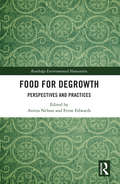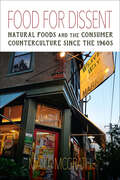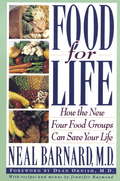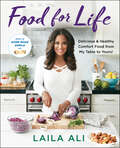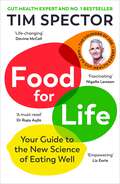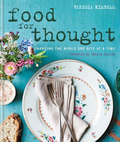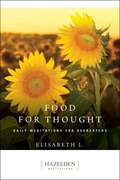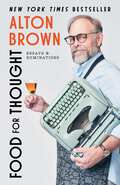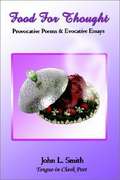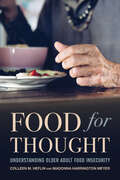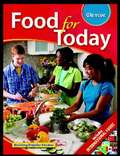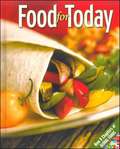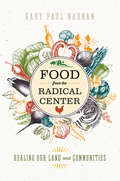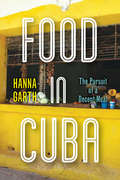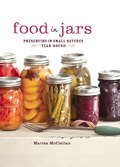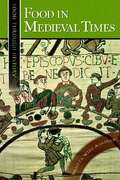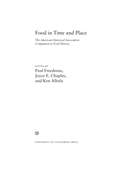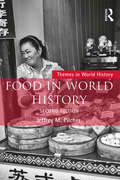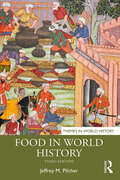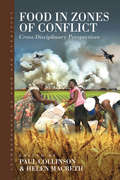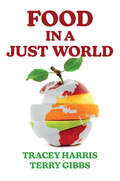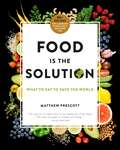- Table View
- List View
Food for Degrowth: Perspectives and Practices (Routledge Environmental Humanities)
by Anitra Nelson and Ferne EdwardsThis collection breaks new ground by investigating applications of degrowth in a range of geographic, practical and theoretical contexts along the food chain. Degrowth challenges growth and advocates for everyday practices that limit socio-metabolic energy and material flows within planetary constraints. As such, the editors intend to map possibilities for food for degrowth to become established as a field of studies. International contributors offer a range of examples and possibilities to develop more sustainable, localised, resilient and healthy food systems using degrowth principles of sufficiency, frugal abundance, security, autonomy and conviviality. Chapters are clustered in parts that critically examine food for degrowth in spheres of the household, collectives, networks, and narratives of broader activism and discourses. Themes include broadening and deepening concepts of care in food provisioning and social contexts; critically applying appropriate technologies; appreciating and integrating Indigenous perspectives; challenging notions of 'waste', 'circular economies' and commodification; and addressing the ever-present impacts of market logic framed by growth. This book will be of greatest interest to students and scholars of critical food studies, sustainability studies, urban political ecology, geography, environmental studies such as environmental sociology, anthropology, ethnography, ecological economics and urban design and planning.
Food for Dissent: Natural Foods and the Consumer Counterculture Since the 1960s
by Maria McGrathIn the 1960s and early 1970s, countercultural rebels decided that, rather than confront the system, they would create the world they wanted. The natural foods movement grew out of this contrarian spirit. Through a politics of principled shopping, eating, and entrepreneurship, food revolutionaries dissented from corporate capitalism and mainstream America. In Food for Dissent, Maria McGrath traces the growth of the natural foods movement from its countercultural fringe beginning to its twenty-first-century "food revolution" ascendance, focusing on popular natural foods touchstones—vegetarian cookbooks, food co-ops, and health advocates. Guided by an ideology of ethical consumption, these institutions and actors spread the movement's oppositionality and transformed America's foodscape, at least for some. Yet this strategy proved an uncertain instrument for the advancement of social justice, environmental defense, and anti-corporatism. The case studies explored in Food for Dissent indicate the limits of using conscientious eating, shopping, and selling as tools for civic activism.
Food for Life
by Neal BarnardCiting overwhelming medical evidence previously downplayed by powerful lobby groups, Dr. Barnard reveals why a diet based on the new four food groups (grains, legumes, vegetables, and fruits) will sharply decrease the risk of cancer and heart disease and dramatically increase life expectancy. He also unveils a 21-day program for a smooth transition to the new way of eating healthfully. Line drawings.From the Trade Paperback edition.
Food for Life: Delicious & Healthy Comfort Food from My Table to Yours!
by Laila AliThe four-time undefeated boxing world champion, cooking personality, and health advocate serves up over 100 sassy recipes that will help you “swap it out.”In Laila’s kitchen, nutrition is King, but flavor is Queen! In her debut cookbook, Laila shows you how to make knockout meals in ways that work with your busy and demanding life, so you can eat healthy, delicious food without feeling hungry!Food for Life shares more than one hundred of Laila’s favorite recipes. Whether you’re new to cooking, busy feeding a family, or ready to eat healthier, Food for Life will be your guidebook!In Food for Life, you’ll find real-life recipes to bring simple, healthy, hearty, and satisfying food to the table, such as:Stovetop RatatouilleOven-”Fried” ChickenWest Coast Southern GreensThe Greatest of All Time Burger (her father’s favorite)Heavenly Lemon Yogurt Cake“If you’re looking for nutritious recipes that ‘go the distance’ when it comes to flavor, look no further. Laila’s new book shows you how to eat like a champion, without sacrificing taste!” —Rachael Ray“What I love about Laila’s cookbook is she’s giving the people what they both need and want . . . flavorful, homestyle recipes that are nutritious and created with love! You can tell that she really put her heart and soul into this book!” —Patti LaBelle“Oven fried chicken, seafood gumbo, and sweet potato pie that won’t clog up your arteries? Laila’s recipes are winning and will keep YOU undefeated!” —Steve Harvey
Food for Life: The New Science of Eating Well, by the Sunday Times bestselling author of SPOON-FED
by Tim Spector'Life-changing' DAVINA McCALL'A must-read' Dr RUPY AUJLA'Fascinating' NIGELLA LAWSON'Empowering' LIZ EARLE**AS HEARD ON THE DIARY OF A CEO PODCAST**Food is our greatest ally for good health, but the question of what to eat in the age of ultra-processed food has never seemed so complicated.Drawing on cutting-edge research and personal insights, Professor Tim Spector offers clear answers in this definitive, easy-to-follow guide to the new science of eating well.Empowering and practical, Food for Life is nothing less than a new approach to how to eat - for our health and the health of the planet.‘No fads, no nonsense, just practical, science-based advice on how to eat well’ Daily Mail, Books of the Year'A rigorously academic book that welcomes the layperson with open arms' The Times** A THE TIMES and SUNDAY TIMES BOOK OF THE YEAR**** WINNER OF THE FORTNUM & MASON SPECIAL AWARD **
Food for Thought: Changing The World One Bite At A Time
by Vanessa KimbellInspired by ethically sourced, sustainable ingredients available from your local suppliers, Vanessa shows how what you cook can make a real difference to those who produce it and to the environment. Recipes are simple, unfussy and easy to cook at home - making everyday classics ethical and sustainable - with chapters focusing on Basics, Getting Ahead in the Kitchen, Simple Suppers, Feeding Children, Leisurely Weekend Food and Special Occasions. Let Vanessa inspire you to adapt the way you cook and change the world one delicious bite at a time.
Food for Thought: Changing the world one bite at a time
by Vanessa KimbellInspired by ethically sourced, sustainable ingredients available from your local suppliers, Vanessa shows how what you cook can make a real difference to those who produce it and to the environment. Recipes are simple, unfussy and easy to cook at home - making everyday classics ethical and sustainable - with chapters focusing on Basics, Getting Ahead in the Kitchen, Simple Suppers, Feeding Children, Leisurely Weekend Food and Special Occasions. Let Vanessa inspire you to adapt the way you cook and change the world one delicious bite at a time.
Food for Thought: Daily Meditations for Overeaters
by Elisabeth L.Food for Thought offers comforting words for compulsive overeaters who seek to understand the role of food in their lives, and helps them support a life of physical, emotional, and spiritual balance.Food for Thought offers wise and comforting words for compulsive overeaters who seek to understand the role of food in their lives. Each day's reading in the best-selling classic--the first Hazelden meditation book to address the needs of overeaters--supports a life of physical, emotional, and spiritual balance.Read daily by millions, Hazelden meditation books have set the standard for quality and popularity. Like all the Hazelden meditation favorites, Food for Thought provides enduring wisdom, reassurance, and strength.
Food for Thought: Essays and Ruminations
by Alton BrownFrom Alton Brown, the New York Times bestselling cookbook author and beloved culinary food personality, a debut collection of personal essays defined by his flair, wit, and insight. From cameraman to chef, musician to food scientist, Alton Brown has had a diverse and remarkable career. His work on the Food Network, including creating Good Eats and hosting Iron Chef America and Cutthroat Kitchen, has resonated with countless viewers and home cooks. Now, he shares exactly what’s on his mind, mixing compelling anecdotes from his personal and professional life with in-depth observations on the culinary world, film, personal style, defining meals of his lifetime, and much more. <p> With his whip-smart and engaging voice, Brown explores everything from wrestling a dumpster full of dough to culinary cultural appropriation to his ultimate quest for the perfect roast chicken. Deliciously candid and full of behind-the-scenes stories fans will love, Food for Thought is the ultimate reading experience for anyone who appreciates food and the people that prepare it. <b>New York Times Bestseller</b>
Food for Thought: Provocative Poems and Evocative Essays
by John L. Smith"Brunch Neither an early breakfast, nor a fashionable late lunch, But rather eaten on the ill-conceived, hopeful hunch, That eating the one single meal, will make you thinner, If to-night you skip your formal, sit-down Sunday dinner. But 1 predict that this will be far from true; For I been watching closely everyone of you. Scoffing bacon, egg, sausage, chicken and danish down. Enough to make the Duchess of York, groan and frown. The problem is, that in having paid table d'hote, A sense of gastronomic proportion is now totally remote, As you eat heartily to get your money's worth. You'll bloat your tummy and backside girth Try to lose the ugly weight you've gained, if you are able, By splitting your sides with laughter while sitting at the table. By applauding each act with an energetic, standing ovation, Much easier than a fortnight of painful, near-starvation True this poem is but one extended pun. And may even make you want to scream, cut and run; But nowadays where can you read, hear and imagine so much fun. So squeaky clean, and not the usual, very crude and very dumb."
Food for Thought: Understanding Older Food Insecurity
by Madonna Harrington Meyer Colleen M. HeflinWhile food insecurity among households with children often makes the headlines, a quieter issue that receives much less attention is the food insecurity faced by older adults. In 2023, over nine percent of Americans age sixty and older were food insecure. Without policy intervention, that number is only expected to grow as the U.S. population continues to age. In Food for Thought social policy scholar Colleen M. Heflin and sociologist Madonna Harrington Meyer illuminate the challenges faced by food insecure older adults. Through analysis of national data sets and interviews with lower income older adults, Heflin and Harrington Meyer describe why many older adults do not have enough money to afford food and other essentials. As a result of chronic economic disadvantage, food insecure older adults are often forced to make budget trade-offs between food and other expenses. In these trade-offs, food typically ranks below housing and energy costs and competes with other household bills, such as medical costs, transportation, and phone and internet coverage. While finances play a large role, nonfinancial factors, such as poor physical, cognitive, and mental health, access to healthy food, and transportation challenges, also contribute to food insecurity in old age. In the face of these difficulties, food insecure older adults may go hungry, skip meals, or eat unhealthy foods to help make ends meet. While SNAP and community-based programs, such as food pantries and home delivered meals, are intended to help address the issue of food insecurity, they are typically inadequate to address the needs of food insecure older adults. SNAP has enrollment and maintenance procedures that are particularly difficult for older adults to navigate, pays out an insufficient amount of money to cover food costs, and varies greatly by state. Availability of community programs varies by municipality, often lacks nutritious foods that are complementary to health conditions common among older adults, and can be difficult to access due to a lack of reliable transportation, disability, or cost. Heflin and Harrington Meyer advocate for addressing all the issues that increase older adults’ risk of food insecurity, not just financial barriers. They suggest updating food insecurity screening tools to include these factors, increasing SNAP benefits and income support for older adults, and other policies to help combat food insecurity in older adults. Food for Thought highlights the increasingly important issue of food insecurity in old age and lays bare the overlooked challenges faced by food insecure older adults.
Food for Today
by Glencoe Mcgraw-HillTreat students to the best and most comprehensive foods textbook with Glencoe's Food for Today! Content is based on the latest research-based nutrition to develop lifelong healthy eating habits. Numerous illustrations, step-by-step activities, and visualization of correct portions are included. All new FACS standards for the foods classroom are met. Focus on food prep and kitchen basics include kitchen tools, safety, and sanitation. Topic-related and point-of-use academic integration with Science in Action and Kitchen Math features help teachers meet Perkins mandates. English language arts and writing activities correlated to national standards. New and revised focus on light and healthy recipes. International recipes are provided. Activities that develop consumer savvy about food choices, nutrition, and keeping a grocery budget are incorporated. Hands-on Kitchen Lab and unit-long projects reinforce concepts through application.
Food for Today (9th edition)
by Helen KowtalukA comprehensive lab-based foods and nutrition program for high school students. It is correlated to the National Standards for Family & Consumer Sciences. Students learn how to make healthy and nutritious food decisions reflecting the most current nutritional guidelines, how to plan meals safely, how to prepare food, how to appreciate food diversity, how science and technology impact foods and nutrition, and about career opportunities in the area of foods and nutrition.
Food for a Happy Gut: Recipes to Calm, Nourish & Heal
by Naomi Devlin'I love working with Naomi. She is a force of nature and her brilliant books have the power to change lives.' Hugh Fearnley-Whittingstall Bestselling author of River Cottage Gluten Free, Naomi Devlin's second book, Food for a Happy Gut, is full of recipes that will calm your digestion, soothe your gut and delight your tastebuds. Giulia Enders' Gut, Michael Mosley's The Clever Guts Diet and the work of Tim Spector among others has helped us realise how vital gut health is to our body, brain and mental health. But a gut-friendly diet need not mean the elimination of favourite foods or hard-to-follow diets. Nutritionist and River Cottage teacher, Naomi Devlin will show you how to keep your gut happy. Move over clean food, this book will take you back to local produce, good home cooking and a wonderfully diverse range of ingredients. Naomi will help you turn your gut into a hub of microbial diversity with lots of plant food, a wide range of meats and fats, plenty of raw cheese, slow-cooking, fermented foods and of course prebiotic and probiotic foods. First calm your gut. If your gut is sensitive, the first section is full of low FODMAP ingredients, seafood, broths and probiotics to soothe your digestion. Then nourish your gut with beneficial foods full of fibre, pre- and probiotics. And finally there are herbs, pickles and teas full of healing properties to stimulate and regulate digestion when you need a little extra help. Neither strict plan or dogma, Naomi's recipes are based on plain good sense and proper science. Food for a Happy Gut is full of delicious, healthy recipes and advice and will feed both your tastebuds and your microbes, leaving you content both inside and out.Chapter breakdown: CALM:BreakfastsSoupsSalads & VegetablesMealsTreatsNOURISH: BreakfastsSoupsSalads & VegetablesMealsTreatsHEAL:Pickled & PreservedSprinkledDressedDrinks & Tonics
Food for a Happy Gut: Recipes to Calm, Nourish & Heal
by Naomi Devlin'I love working with Naomi. She is a force of nature and her brilliant books have the power to change lives.' Hugh Fearnley-Whittingstall Bestselling author of River Cottage Gluten Free, Naomi Devlin's second book, Food for a Happy Gut, is full of recipes that will calm your digestion, soothe your gut and delight your tastebuds. Giulia Enders' Gut, Michael Mosley's The Clever Guts Diet and the work of Tim Spector among others has helped us realise how vital gut health is to our body, brain and mental health. But a gut-friendly diet need not mean the elimination of favourite foods or hard-to-follow diets. Nutritionist and River Cottage teacher, Naomi Devlin will show you how to keep your gut happy. Move over clean food, this book will take you back to local produce, good home cooking and a wonderfully diverse range of ingredients. Naomi will help you turn your gut into a hub of microbial diversity with lots of plant food, a wide range of meats and fats, plenty of raw cheese, slow-cooking, fermented foods and of course prebiotic and probiotic foods. First calm your gut. If your gut is sensitive, the first section is full of low FODMAP ingredients, seafood, broths and probiotics to soothe your digestion. Then nourish your gut with beneficial foods full of fibre, pre- and probiotics. And finally there are herbs, pickles and teas full of healing properties to stimulate and regulate digestion when you need a little extra help. Neither strict plan or dogma, Naomi's recipes are based on plain good sense and proper science. Food for a Happy Gut is full of delicious, healthy recipes and advice and will feed both your tastebuds and your microbes, leaving you content both inside and out.Chapter breakdown: CALM:BreakfastsSoupsSalads & VegetablesMealsTreatsNOURISH: BreakfastsSoupsSalads & VegetablesMealsTreatsHEAL:Pickled & PreservedSprinkledDressedDrinks & Tonics
Food from the Radical Center: Healing Our Land and Communities
by Gary Paul Nabhan"Informational and inspirational."—BooklistAmerica has never felt more divided. But in the midst of all the acrimony comes one of the most promising movements in our country's history. People of all races, faiths, and political persuasions are coming together to restore America's natural wealth: its ability to produce healthy foods.In Food from the Radical Center, Gary Nabhan tells the stories of diverse communities who are getting their hands dirty and bringing back North America's unique fare: bison, sturgeon, camas lilies, ancient grains, turkeys, and more. These efforts have united people from the left and right, rural and urban, faith-based and science-based, in game-changing collaborations. Their successes are extraordinary by any measure, whether economic, ecological, or social. In fact, the restoration of land and rare species has provided—dollar for dollar—one of the best returns on investment of any conservation initiative.As a leading thinker and seasoned practitioner in biocultural conservation, Nabhan offers a truly unique perspective on the movement. He draws on fifty years of work with community-based projects around the nation, from the desert Southwest to the low country of the Southeast. Yet Nabhan's most enduring legacy may be his message of hope: a vision of a new environmentalism that is just and inclusive, allowing former adversaries to commune over delicious foods.
Food in Cuba: The Pursuit of a Decent Meal
by Hanna GarthFood in Cuba follows Cuban families as they struggle to maintain a decent quality of life in Cuba's faltering, post-Soviet welfare state by specifically looking at the social and emotional dimensions of shifts in access to food. Based on extensive fieldwork with families in Santiago de Cuba, the island's second largest city, Hanna Garth examines Cuban families' attempts to acquire and assemble "a decent meal," unraveling the layers of household dynamics, community interactions, and individual reflections on everyday life in today's Cuba. With the collapse of the Soviet Union in the 1990s and the subsequent loss of its most significant trade partner, Cuba entered a period of economic hardship. Although trade agreements have significantly improved the quantity and quality of rationed food in Cuba, many Cubans report that they continue to live with food shortages and economic hardship. Garth tells the stories of families that face the daily challenge of acquiring not only enough food, but food that meets local and personal cultural standards. She ultimately argues that these ongoing struggles produce what the Cuban families describe as "a change in character," and that for some, this shifting concept of self and sense of social relation leads to a transformation in society. Food in Cuba shows how the practices of acquisition and the politics of adequacy are intricately linked to the local moral stances on what it means to be a good person, family member, community member, and ultimately, a good Cuban.
Food in Jars: Preserving in Small Batches Year-Round
by Marisa McclellanPopular food blogger Marisa McClellan takes you through all manner of food in jars, storing away the tastes of all seasons for later. Basics like jams and jellies are accompanied by pickles, chutneys, conserves, whole fruit, tomato sauces, salsas, marmalades, nut butters, seasonings, and more. Small batches make them easy projects for a canning novice to tackle, and the flavors of vanilla bean, sage, and pepper will keep more experienced jammers coming back for more. aSample some Apricot Jam and Rhubarb Syrup in the spring, and then try your hand at Blueberry Butter and Peach Salsa in the summer; Dilly Beans and Spicy Pickled Cauliflower ring in the fall, while Three-Citrus Marmalade and Cranberry Ketchup are the harbingers of winter. Stories of wild blackberry jam and California Meyer lemon marmalade from McClellanOCOs childhood make for a read as pleasurable as it is delicious; her home-canned foodOColearned from generations of the original OC foodiesOCOOCofeeds the soul as well as the body in more than 100 recipes. "
Food in Medieval Times
by Melitta Weiss AdamsonFew medieval cookbooks have survived from earlier than the 14th century and those typically reflect the cuisine of the elite. In a study of culture in the Middle Ages viewed through food-related themes, Adamson (modern languages and literatures, U. of Western Ontario) describes the cultivation and use of various foodstuffs, cooking methods, cuisines of several European countries, eating habits, and notions about nutrition. She includes a timeline, period illustrations, glossary, suggested further reading, and an index of such recipes as eel pie and stuffed buried Jewish dish (a stew). Annotation ©2004 Book News, Inc., Portland, OR (booknews.com)
Food in Time and Place
by Ken Albala Joyce E. Chaplin Paul FreedmanFood and cuisine are important subjects for historians across many areas of study. Food, after all, is one of the most basic human needs and a foundational part of social and cultural histories. Such topics as famines, food supply, nutrition, and public health are addressed by historians specializing in every era and every nation.Food in Time and Place delivers an unprecedented review of the state of historical research on food, endorsed by the American Historical Association, providing readers with a geographically, chronologically, and topically broad understanding of food cultures--from ancient Mediterranean and medieval societies to France and its domination of haute cuisine. Teachers, students, and scholars in food history will appreciate coverage of different thematic concerns, such as transfers of crops, conquest, colonization, immigration, and modern forms of globalization.
Food in World History
by Jeffrey M. PilcherThe second edition of this concise survey offers a comparative and comprehensive study of culinary cultures and food politics throughout the world, from ancient times to the present day. It examines the long history of globalization of foods as well as the political, social, and environmental implications of our changing relationship with food, showing how hunger and taste have been driving forces in human history.? Including numerous case studies from diverse societies and periods, Food in World History explores such questions as: What social factors have historically influenced culinary globalization? How did early modern plantations establish patterns for modern industrial food production? Were eighteenth-century food riots comparable to contemporary social movements around food? Did Italian and Chinese migrant cooks sacrifice authenticity to gain social acceptance in the Americas? Have genetically modified foods fulfilled the promises made by proponents? This new edition includes expanded discussions of gender and the family, indigeneity, and the politics of food. Expanded chapters on contemporary food systems and culinary pluralism examine debates over the concentration of corporate control over seeds and marketing, authenticity and exoticism within the culinary tourism industry, and the impact of social media on restaurants and home cooks.
Food in World History (Themes in World History)
by Jeffrey M. PilcherNow in its third edition, Food in World History explores culinary cultures and food politics throughout the world, from ancient times to the present day, with expanded discussions of industrialization, indigeneity, colonialism, gender, environment, and food and power. It examines the long history of globalization of foods as well as the political, social, and environmental implications of our changing relationship with food, showing how hunger and taste have been driving forces in human history. Including numerous case studies from diverse societies and periods, such as Maya and Inca cuisines and peasant agriculture in the early modern era, Food in World History explores such questions as: What social factors have historically influenced culinary globalization? How did early modern plantations establish patterns for modern industrial food production? How will the climate crisis affect food production and culinary cultures? Did Italian and Chinese migrant cooks sacrifice authenticity to gain social acceptance in the Americas? Have genetically modified foods fulfilled the promises made by proponents? With the inclusion of more global examples, this comprehensive survey is an ideal resource for all students who study food history or food studies.
Food in Zones of Conflict: Cross-Disciplinary Perspectives (Anthropology of Food & Nutrition #8)
by Helen Macbeth Paul CollinsonThe availability of food is an especially significant issue in zones of conflict because conflict nearly always impinges on the production and the distribution of food, and causes increased competition for food, land and resources Controlling the production of and access to food can also be used as a weapon by protagonists in conflict. The logistics of supply of food to military personnel operating in conflict zones is another important issue. These themes unite this collection, the chapters of which span different geographic areas. This volume will appeal to scholars in a number of different disciplines, including anthropology, nutrition, political science, development studies and international relations, as well as practitioners working in the private and public sectors, who are currently concerned with food-related issues in the field.
Food in a Just World: Compassionate Eating in a Time of Climate Change
by Tracey Harris Terry GibbsFood in a Just World examines the violence, social breakdown, and environmental consequences of our global system of food production, distribution, and consumption, where each step of the process is built on some form of exploitation. While highlighting the broken system’s continuities from European colonialism, the authors argue that the seeds of resilience, resistance, and inclusive cultural resurgence are already being reflected in the day-to-day actions of communities around the world. Calling for urgent change, the book looks at how genuine democracy would give individuals and communities meaningful control over the decisions that impact their lives when seeking to secure humanely this most basic human need. Drawing on the perspectives of advocates, activists, workers, researchers, and policymakers, Harris and Gibbs explore the politics of food in the context of capitalist globalization and the climate crisis, uncovering the complexities in our relationships with one another, with other animals, and with the natural world.
Food is the Solution: What to Eat to Save the World--80+ Recipes for a Greener Planet and a Healthier You
by Matthew Prescott<p>In Food Is the Solution, Matthew Prescott, Senior Food Policy Director for the Humane Society and a leader in the environmental food movement, shows how our plates have the power to heal the world. This lavishly designed resource and recipe collection shows how anyone can help solve the world’s major issues—environmental problems chief among them—simply by incorporating more plants into their diets. <p>Featuring investigative reporting, compelling infographics, and essays from notable contributors like Dr. Michael Greger, John Mackey, James Cameron, Paul McCartney, and Wolfgang Puck, Food Is the Solution will inspire us all to put more plants on our plates. What we eat will determine what kind of world we live in and what kind of world we live on—and Matthew Prescott proves that meat-heavy diets are destroying the planet. <p>Imagine a world in which we are all healthier. Imagine a world where the air is clean, forests dense, water pure, and animal life healthy. That world is a happier world, a better world—and the delectable plant-based foods Prescott shows us how to prepare in Food Is the Solution will help us create it.</p>
